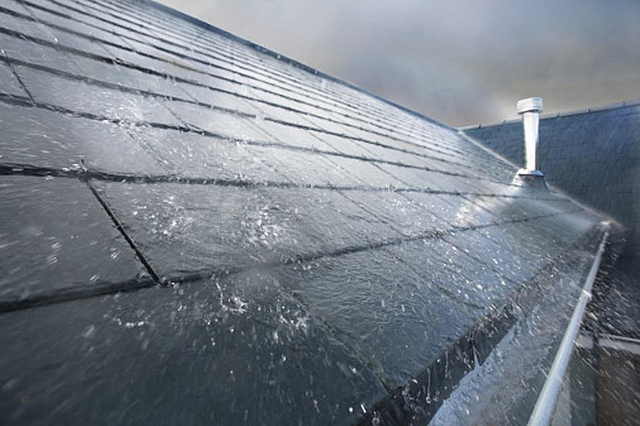
How homeowners can help solve a water shortage crisis, one rooftop at a time
Many U.S. and Canadian homeowners are now welcoming fall rains – a much needed seasonal change especially for dry and arid regions that continue to battle annual drought and water shortages.
But with all the precious precipitation now falling from the sky, it begs the question: Is there a simple way you can utilize this season’s rainwater and winter ice and snow melt to help alleviate the strain of water scarcity right at home?
The good news is collecting rainwater is one of the most accessible and economically viable options available to deal with the freshwater crisis. It’s also relatively simple and straight-forward to do. Rainwater harvesting means collecting run-off from a roof via gutters designed to channel water into a storage vessel. Storage can be as small as rain barrels that keep a few gallons of non-potable water handy for watering plants and the like, or they can be as elaborate as large cisterns that supply an entire household’s potable needs (when properly filtered, disinfected and tested).
Even rainfall harvesting on a smaller scale can make a big difference: One inch of rainfall on 1,000 square feet yields an incredible 623 gallons of water.
“By choosing the right roof and some simple planning to set up a system, it’s amazing the difference homeowners can make when it comes to contributing to their home’s own water supply via rooftop rain harvesting,” said Renee Ramey, Metal Roofing Alliance (MRA) executive director.
Rainwater harvesting 101: It’s all about the right rooftop
When considering a home rainwater harvesting system, your home’s roof is one of the single most important components. Roofs made from a variety of materials including asphalt, slate or tile can be used for collecting rainwater. However, metal is preferred. Some experts warn that older shingled (asphalt) roofs made before 1980 may contain asbestos which is hazardous if disturbed. Even if your shingles are new, not all varieties are safe for water collection and can leach contaminants and large chunks of grit. Some even go so far as to not recommend collecting water from an asphalt shingled roof in the first three years following installation, to give the installation adhesives time to off-gas.
While research varies on whether toxins may leach from materials like asphalt, the real concern when it comes to rainwater harvesting is how best to reduce the potential contaminants that grow on the roofing material itself. Compared to other materials, metal roofs have much lower concentrations of dissolved organic carbon and other bacteria. That’s because metal roofs are often coated in anti-microbial paint systems, meaning they will shed larger organic matter more quickly and don’t have cracks and crevices that may allow harmful microorganisms to grow. Galvanized and Galvalume metal roofs also are ideal as they are coated with a layer of zinc which seals the material, preventing rust and lowering levels of iron in the water.
Remember that rainwater harvested from any type of roof, including metal, should always be filtered, and decontaminated before use. This is absolutely essential for any harvested water used inside the home for consumption.
Water falls and why slopes matter
A roof’s angle or slope will determine the speed and rate at which water will collect. Keep in mind that a steep-sloped roof will shed water much more quickly and perform better to help keep debris and other foreign materials at bay. The greater the slope, the better it can perform to prevent stagnant water buildup and contaminants.
Metal roofs also are durable and strong enough to withstand the intensity of heavy rain and weight of snow and ice, and well-built metal roofing systems with properly designed gutters and downspouts provide an easy and efficient path for water to travel, even for low-sloped roofs.
Key rooftop components: What to consider
While rainwater collection systems are typically very basic and easy to use, the best time to plan for them is when installing a new roof or reroofing your home. Working with your installer, a few key things to know:
- You can collect rainwater from any type or shape of gutter. No special gutter is needed.
- Your gutters should have protection screening to help keep large debris out.
- An additional filtration opportunity is available with the installation of a rain head (downspout filter) that allows for more self-cleaning. A first-flush diverter also helps prevent the first flush of contaminated rainwater from entering your storage container/tank.
- Ideally, you should already have a plan for storage in place so your installer can plan for and retrofit downspouts and connection points as appropriate.
- Keeping your roof clean and ongoing maintenance also is important. Fortunately, today’s quality metal roofs are exceptionally easy to clean with gentle, non-toxic methods that call for plain water and some mild, biodegradable soap if needed.
For more information about today’s quality metal roofs, download your free MRA Buyer’s Guide.